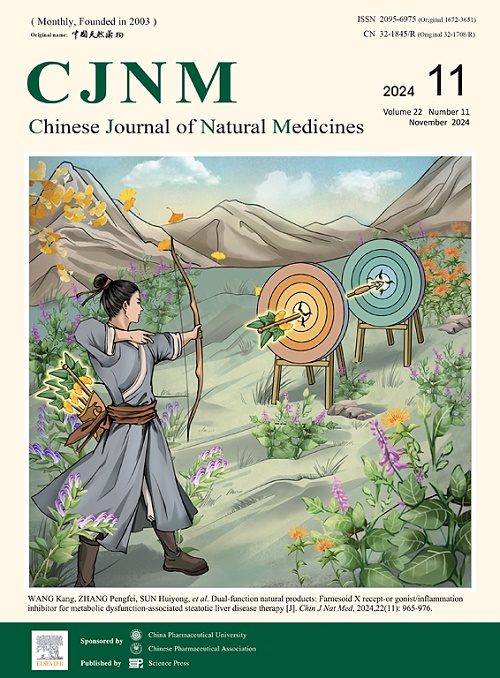人参皂苷对纤维化相关疾病的潜在治疗作用:分子机制综述及进一步研究的展望
IF 4.9
2区 医学
Q1 INTEGRATIVE & COMPLEMENTARY MEDICINE
引用次数: 0
摘要
纤维化的特征是一种异常的修复过程,涉及结缔组织直接替代受损或死亡的细胞,导致各种组织和器官的进行性建筑重塑。这种情况造成了沉重的负担,导致相当高的发病率和死亡率。人参(Panax Ginseng C. a . Meyer)以其药用特性而闻名,已被纳入中成药的关键成分,以减轻纤维化疾病。人参皂苷作为人参中的主要生物活性物质,受到了广泛的关注。在过去的五年中,广泛的研究已经探索了人参皂苷在不同器官纤维化条件下的药物潜力,包括肝、心肌、肾和肺纤维化。研究表明,人参皂苷对实质细胞损伤、导致细胞外基质(ECM)产生的肌成纤维细胞激活、肌成纤维细胞凋亡或失活等炎症反应有潜在影响。此外,与这些病理过程相关的潜在下游靶点和途径已被确定为受人参皂苷的影响。本文综述了利用人参皂苷治疗各种类型组织纤维化的有效方法及其潜在的抗纤维化机制。为未来器官纤维化治疗的新型候选药物的开发提供参考。本文章由计算机程序翻译,如有差异,请以英文原文为准。
The potential therapeutic role of ginsenosides on fibrosis-associated diseases: a review on molecular mechanisms and call for further research
Fibrosis is characterized as an aberrant reparative process involving the direct replacement of damaged or deceased cells with connective tissue, leading to progressive architectural remodeling across various tissues and organs. This condition imposes a substantial burden, resulting in considerable morbidity and mortality. Ginseng (Panax ginseng C. A. Meyer), renowned for its medicinal properties, has been incorporated as a key component in Chinese patent medicines to mitigate fibrotic diseases. Ginsenosides, the primary bioactive compounds in ginseng, have garnered significant attention. Over the past five years, extensive research has explored the pharmaceutical potential of ginsenosides in diverse organ fibrosis conditions, including liver, myocardial, renal, and pulmonary fibrosis. Studies have elucidated that ginsenosides demonstrate potential effects on inflammatory responses stemming from parenchymal cell damage, myofibroblast activation leading to extracellular matrix (ECM) production, and myofibroblast apoptosis or inactivation. Additionally, potential downstream targets and pathways associated with these pathological processes have been identified as being influenced by ginsenosides. This review presents a comprehensive overview of the efficacious treatments utilizing ginsenosides for various tissue fibrosis types and their potential anti-fibrotic mechanisms. Furthermore, it offers a reference for the development of novel candidate drugs for future organ fibrosis therapies.
求助全文
通过发布文献求助,成功后即可免费获取论文全文。
去求助
来源期刊

Chinese Journal of Natural Medicines
INTEGRATIVE & COMPLEMENTARY MEDICINE-PHARMACOLOGY & PHARMACY
CiteScore
7.50
自引率
4.30%
发文量
2235
期刊介绍:
The Chinese Journal of Natural Medicines (CJNM), founded and sponsored in May 2003 by China Pharmaceutical University and the Chinese Pharmaceutical Association, is devoted to communication among pharmaceutical and medical scientists interested in the advancement of Traditional Chinese Medicines (TCM). CJNM publishes articles relating to a broad spectrum of bioactive natural products, leading compounds and medicines derived from Traditional Chinese Medicines (TCM).
Topics covered by the journal are: Resources of Traditional Chinese Medicines; Interaction and complexity of prescription; Natural Products Chemistry (including structure modification, semi-and total synthesis, bio-transformation); Pharmacology of natural products and prescription (including pharmacokinetics and toxicology); Pharmaceutics and Analytical Methods of natural products.
 求助内容:
求助内容: 应助结果提醒方式:
应助结果提醒方式:


